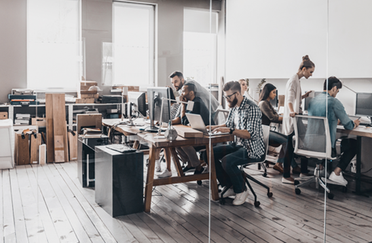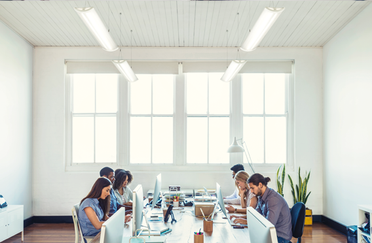3 Things to remember when lighting offices
It's time to take a more holistic approach to lighting, and consider not just how well it lights the tasks we're doing, but also how well it lights the spaces we work in, and the people we work with. Here's how to get these three key points right.
The science of how light influences our bodies has advanced hugely in the past two decades. But we still have much to learn, and there remains a lack of evidence for how best to put the knowledge into practice in the workplace. In the coming years we can expect to see our knowledge of this area continue to advance. In the meantime there are simple principles that every lighting professional can follow to make sure the lighting in an office creates a healthy, comfortable atmosphere. This means not just focusing on lighting for workplace “tasks”, but taking a more holistic approach. The three essential elements to consider when lighting an office are: task, space and face. Lighting schemes that successfully combine all three of these elements will create an atmosphere that is pleasant and productive. Here’s how!
TASK 01 Lighting must provide the right level of light for people to carry out tasks effectively. EN12464 specifies luminance levels for various activities. Older workers and workers with poorer eyesight may need higher levels of light than others. Many offices now place an increasing emphasis on flexible working, online, face-to-face meetings and conversations. Lighting must be flexible enough to work well in all of these situations. Computers, tablets and phones with backlit screens are everywhere in the modern office, so glare that could make these difficult to use must be avoided. |  |
 | TASK 02 Whether it’s a meeting, a video conference or a chat by the water cooler, lighting needs to allow us to see each other’s faces clearly. The key factors are cylindrical illuminance, facial modelling and good colour rendering. EN12464 specifies 150 lux cylindrical illuminance at head height and a modelling index of between 0.3 and 0.6. This creates an environment where we feel comfortable, look good, and can see each other clearly enough read our colleagues’ expressions, mood and body language. It also makes sure that enough light is reaching people’s eyes to keep them alert. Every workplace is unique and will require the lighting of task, space and face to be considered and balanced differently. But keep these three priorities in mind, and you can be confident that your lighting will keep workers performing effectively. |
TASK 03 In the past, office lighting has often focused only on lighting for the task, which usually meant lighting desk surfaces and avoiding glare on screens. This inadvertently created the so-called “cave effect”, resulting in gloomy offices and drowsy workers. Considering carefully how we light the space around us avoids these problems, helping to create an environment where workers can feel comfortable and alert. Diffuse, well distributed light with a mix of vertical and horizontal illumination is important. Bright ceilings and upper walls also make a space feel more pleasant. EN12464 specifies light levels for the task area, the immediate surroundings, and areas beyond. It also specifies uniformity levels for task areas, as well as light to walls and ceilings, to make sure there isn’t too much contrast between light and dimmer areas. |  |
The colour of light also has an important influence on the ambience of an office. Warmer colour temperatures are associated with relaxation, while cooler lights are considered more appropriate for a work environment. Compromising on colour temperature or colour rendering will have a big impact on the working atmosphere you create. Just as important as making sure there’s enough light in a space is making sure there isn’t too much glare, which can cause headaches and eye strain, as well as making it harder to see what we’re doing, and harder to use computers, phones and tablets. Glare can be controlled through careful lighting design and choosing luminaires with good optical design, to keep office workers comfortable and focused.
